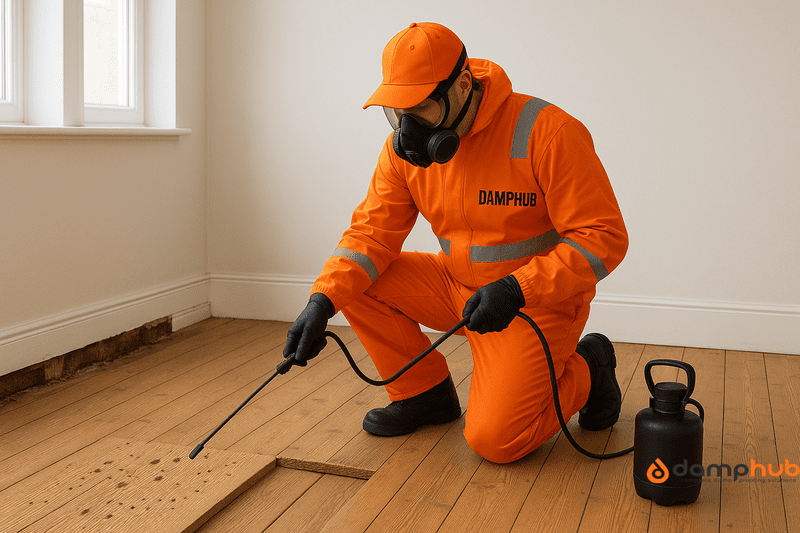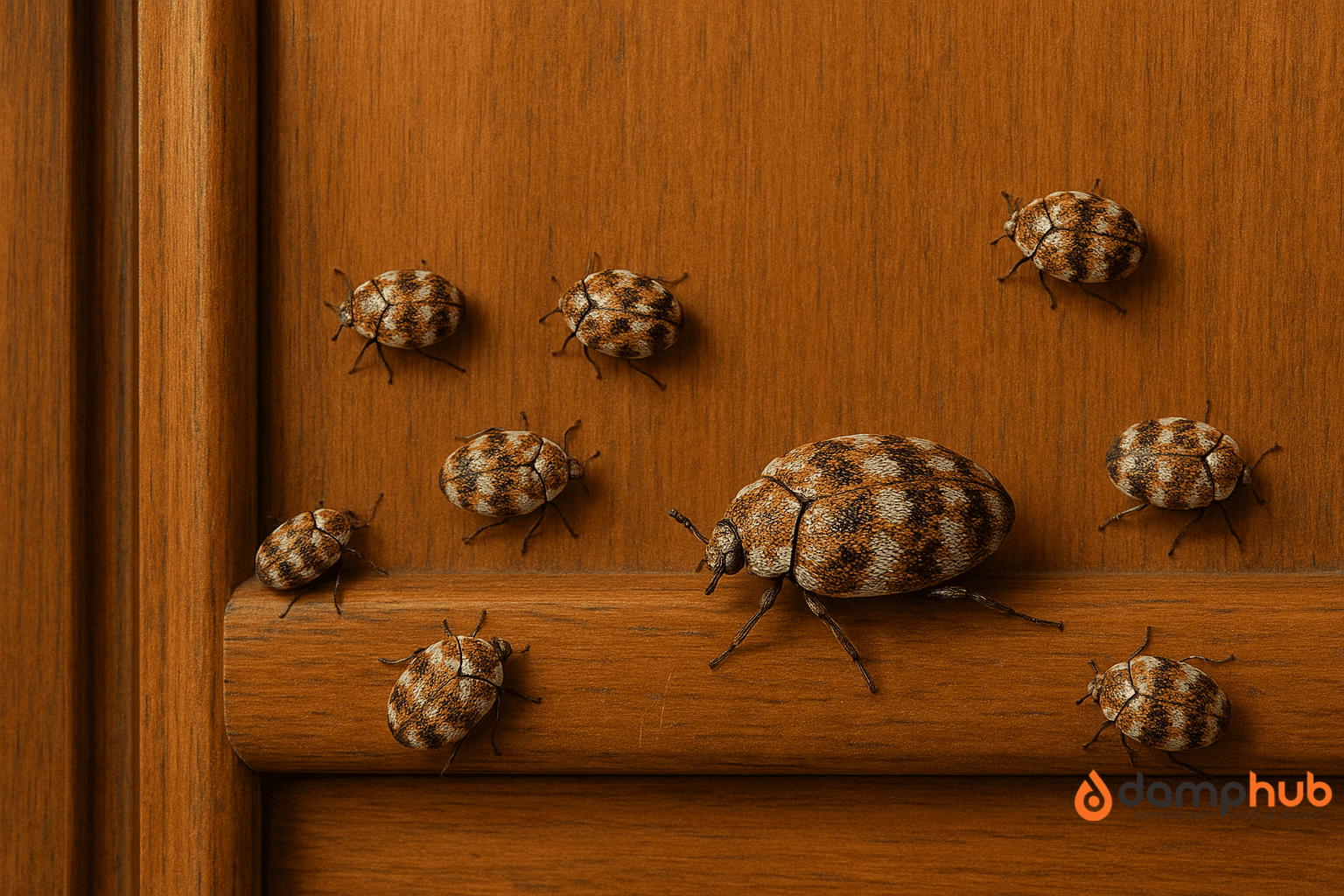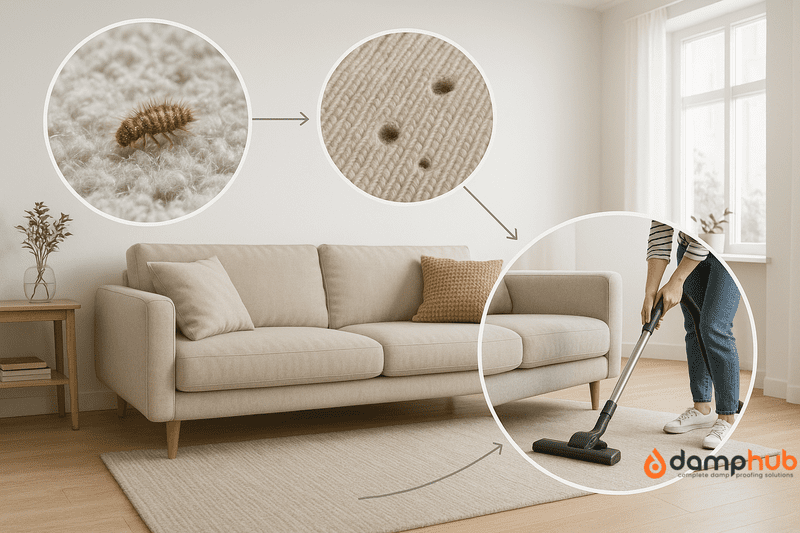
What are carpet beetle larvae? They are the immature form of the carpet beetles. They come around in your home when the mature carpet beetles lay eggs, which hatch into larvae.
One thing that you need to know is that these carpet beetles lay eggs in very hidden spaces, so you won’t easily notice them even when they hatch.
Think of it like the mature beetles you typically see near lights or flying in or out through the window are on a mission – to lay eggs in your home and leave or die. The mission is over.
Now handed down to the hatching larvae. These are the real homewreckers—literally.
You won’t hear them coming. No buzzing. No scratching. Not even a warning nibble. But they’ll leave their mark all the same.
They don’t bite humans. But they will bite memories—like the scarf your nan knitted or the rug you splurged on in a moment of reckless adulthood. These hairy grubs don’t care.
Fortunately, before they do any damage, we’ll expose them—what they look like, where they hide, and how to send them packing before they turn your home into a snack bar.
Guide👉: What Is a Varied Carpet Beetle?
What Do Carpet Beetle Larvae Look Like?
Carpet beetle larvae are the greedy little stage before the beetle becomes an adult. They’re not much to look at — just tiny, fuzzy grubs, usually somewhere between 2 and 5 millimetres long. Brownish or golden, with faint stripes, and covered in stiff hairs that make them look a bit like walking lint with attitude.
They’re shy, too — not in a sweet way, more in a “I’m going to chew through your jumpers while you’re not looking” kind of way. You’ll usually find them tucked away in places you haven’t cleaned since the Queen’s Jubilee — under carpets, behind the sofa, inside the folds of that winter coat you forgot you owned.
Want to spot them? Look for tiny, hairy things crawling near wool, feathers, or silk. And keep an eye out for little dry skins — they shed those as they grow, leaving behind crispy clues like a crime scene you didn’t notice until months too late.
Here’s the kicker:
The adults barely eat. But the larvae? They’re basically stomachs on legs. They need constant fuel to grow — and they get it by tearing through anything that once came from an animal. Wool, felt, fur, even old taxidermy if you’ve got some lurking in the loft. Nothing is sacred.
How Do Carpet Beetle Larvae Get into your Home?
They’re freeloaders. And like most freeloaders, they don’t knock.
They sneak in through the tiniest gaps. Open windows. Cracks in the loft. That cute vintage armchair you found at the car boot. Even your pets can carry them in.
Once inside the mission starts. Laying eggs on natural fibres—just a few here, a few there—and letting the larvae hatch into a ready-made buffet.
You didn’t invite them in. But once they’ve found your stash of wool blankets and old photo albums, they’ll act like they’ve always lived there.
What are the Signs of Carpet Beetle Larvae in my Home?
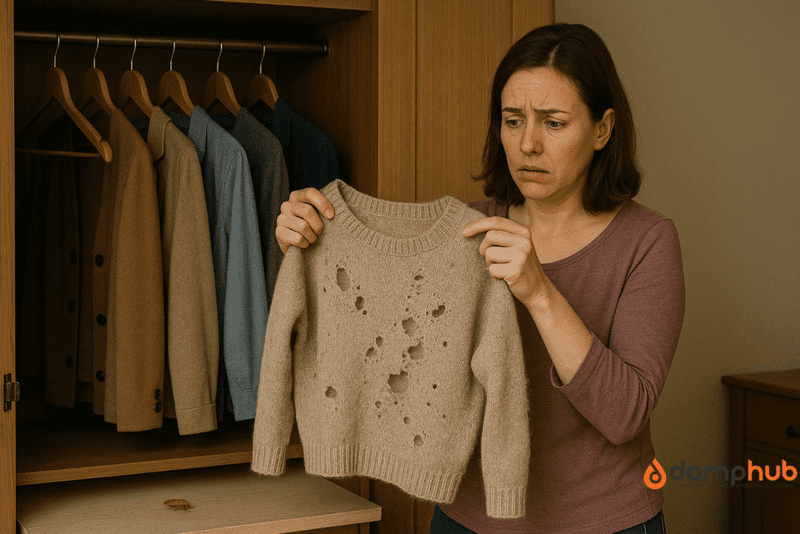
If you wait until the damage is obvious, you’ve waited too long.
You’ll need to go full inspector mode. Pull furniture away from the walls. Peek inside drawers you haven’t opened since 2017. Check the seams of cushions, behind skirting boards, and under the bed.
Look for carpet beetle infestation signs like:
- Tufts of shed bristles (like dusty little cigars).
- Tiny trails of fabric dust in quiet corners.
- Ragged holes in the edges of carpets or behind doors.
This isn’t a surface-level pest. They’re in the places you don’t clean. And let’s be honest—every house has at least one of those. If you agree, the next thing should be checking those areas after reading this guide.
How Do You Identify Carpet Beetle Eggs?
Carpet beetle eggs are small enough to escape notice — usually white or cream, no more than 0.25 to 0.5 millimetres long. They’re oval-shaped and often have tiny, bristle-like projections on one end, which can help distinguish them from bits of dust or lint.
These eggs aren’t laid out in the open. Instead, they’re hidden where there’s warmth, darkness, and food for the larvae once they hatch. You’ll often find them along the edges of carpets, deep in wardrobes, behind baseboards, or inside air ducts.
Anywhere undisturbed and lined with natural fibres — that’s where they settle.

What are the Signs of Carpet Beetle Larvae Infestation?
Sometimes it’s a clothes. Sometimes a cushion. Sometimes a weird, sudden bald patch in the rug that nobody will admit to noticing until now.
Common signs of carpet beetle larvae damage include:
- Damage to natural fabrics, especially where lighting is poor.
- Clusters of dead adult beetles on windowsills.
- Shed larval skins—dry, hollow, and shaped like tiny croissants of doom.
- Mysterious allergies or carpet beetle rashes that come and go.
Also, if it feels like your stuff is slowly thinning out on its own, it’s probably them.
What Specific Household Items are Most at risk of Larval Damage?
Let’s play a game called “Is it edible (to a carpet beetle)?”
- Wool jumper? Yes.
- Vintage felt hat? Yes.
- Leather satchel? Surprisingly, yes.
- Fake fur throw? Probably not… unless it’s mixed with wool.
- Feathers, pet hair, taxidermy, upholstery, even bristle brushes? All fair game.
Basically, if it once lived, they’re into it. This isn’t just a wardrobe problem—it’s a soft furnishings apocalypse waiting to happen.
Where Do Carpet Beetle Larvae Hide?
They have a PhD in hiding.
Common hideouts:
- Under heavy furniture (especially stuff you haven’t moved in years).
- In air vents, behind radiators, inside floorboards.
- Inside upholstered furniture and the seams of cushions.
- In lofts, airing cupboards, or around chimney breasts.
If you’ve ever dropped something and thought, “Eh, it’s probably fine under there,” congratulations—that’s now a larval hideout.
More from us👉 How to Identify and Get Rid of Black Carpet Beetles
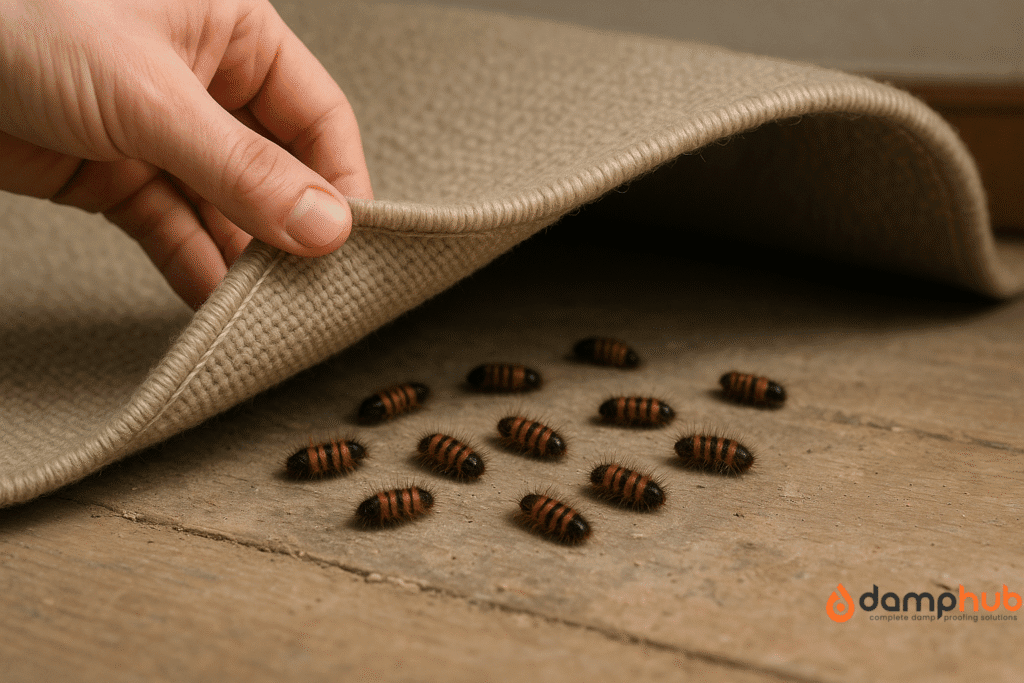
How Can I Tell if my Infestation is from Carpet Beetle Larvae or Other Pests?
Not all fabric damage is equal. And you don’t want to waste weeks chasing the wrong culprit.
Quick breakdown:
- Carpet beetle larvae: Hairy. Slow. Ragged damage on wool or silk. Often found solo.
- Moth larvae: Silky webbing near holes. Tend to stick to wardrobes.
- Silverfish: Fast and silver. Like glue and books more than fabric.
- Fleas: Jump. Bite. Annoy. No fabric damage, but big attitude.
Still stuck? Catch one in a jar. (Not fun, but weirdly satisfying.) Or send a photo to a pest pro—they’ll know instantly and help with beetle removal and pest prevention.
Carpet Beetles vs Other Common Pests
| Pest | Key Traits | Damage Signs | Common Locations |
|---|---|---|---|
| Carpet Beetle Larvae | Hairy, slow-moving, often alone | Ragged holes in wool, silk, or natural fibres | Carpets, under furniture, corners |
| Moth Larvae | Leave silky webbing, slower than beetles | Small holes, often clustered | Wardrobes, drawers, dark closets |
| Silverfish | Fast, silver, scurry away quickly | Prefer glue, paper, and starch | Bookshelves, basements, bathrooms |
| Fleas | Tiny, jumping, bite humans and pets | No fabric damage—itchy bites instead | Pet bedding, carpets, sofas |
Can Carpet Beetle Larvae Harm Humans?
Not directly. They won’t nibble you in your sleep or crawl into your ear.
But here’s the catch: the tiny hairs on the larvae can irritate sensitive skin. If you wake up itchy with no bites, and your skin looks blotchy or rashy—especially near the waistline or armpits—it could be from contact with infested fabric.
It’s not dangerous. Just deeply annoying. Like being allergic to the fabric you bought because it was “natural and breathable.”
What are the Most Effective Natural Repellents to keep Larvae Away Long-term?
They hate strong smells. Time to weaponise your herbs and oils.
Try:
- Cedar chips or blocks—stick them in drawers and wardrobes.
- Lavender sachets—smells great, drives them mad.
- Bay leaves or cloves—not just for stew anymore.
- Essential oils—peppermint, eucalyptus, tea tree.
And let’s not forget the best natural weapon of all: light. Open those curtains. Air things out. They thrive in darkness and stillness. So make your home feel lived in, not forgotten.
How Do You Get Rid of Carpet Beetle Larvae Naturally?
Roll up your sleeves. This isn’t a one-spray-fixes-everything job.
Here’s your natural plan of attack:
- Vacuum like a maniac—edges, corners, vents, the backs of drawers. Everywhere.
- Wash and freeze—hot water for fabrics, deep freeze anything delicate.
- Steam clean carpets—heat + pressure = larval meltdown.
- Use herbs or essential oils—we’re talking saturation, not a polite whiff.
- Declutter—less stuff = fewer places to hide.
It’s war. But a winnable one.
Want to know more? Read: What Is the Woolly Bear Carpet Beetle?
What Kills Carpet Beetle Larvae Instantly?
You want scorched earth? Here’s what works:
- Boric acid—they walk through it, they die. Simple.
- Permethrin sprays—lethal to insects, safe when dry. Use gloves.
- Insect growth regulators (IGRs)—mess with their development so they never grow up.
Pro Tip:
Don’t just spray and pray. Larvae hide deep. Hit them where they live—under rugs, inside vents, between floorboards.
How can you Prevent Carpet Beetle Larvae from Coming Back?
Think like a pest. If you were small, hairy, and hungry, where would you go?
Now block it.
- Vacuum often—especially those dead zones under sofas and wardrobes.
- Seal up entry points—gaps in skirting, vents, windows.
- Inspect second-hand finds—treat vintage as suspicious until proven safe.
- Store fabrics smartly—sealed containers only. Not under beds.
And make a habit of disturbing the peace. The more often you move things, the less chance they have to settle.
When to Seek Professional Help for Persistent Carpet Beetle Larvae?
If you’re still finding damage after cleaning like a possessed Marie Kondo, it’s time.
Call in the experts if:
- The larvae keep coming back no matter what you do.
- The infestations’s made it into walls or ducts.
- You’re seeing beetles and moths and who knows what.
A pest control professional won’t just nuke them—they’ll find out how they got in and why they stayed.
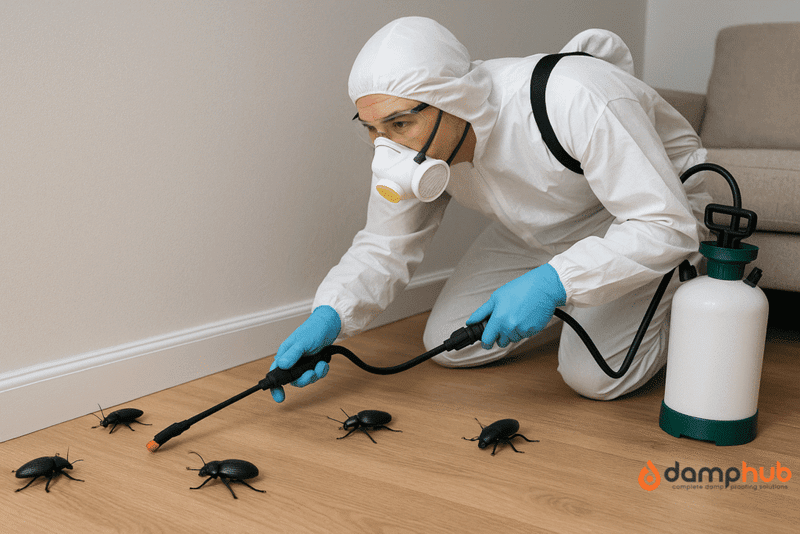
Final Thoughts
Our other guide👉 How to Prevent Carpet Beetle Bites?
Carpet beetle larvae aren’t the dramatic, flying, jump-scare pests. They’re quiet. Subtle. Patient. And that makes them more dangerous.
But they’re beatable. You just have to be as persistent as they are—and a bit more creative.
Start with light. Add some lavender. Vacuum like it’s cardio. And if it still feels like your house has more fluff than it should, call someone who deals with fluff professionally.
Trust your instincts. Holes don’t appear out of nowhere.
FAQs

-
How long do carpet beetle eggs survive?
Carpet beetle eggs typically hatch within 7 to 35 days, depending on temperature and humidity. If conditions aren’t ideal, some may take a bit longer—but most don’t “survive” beyond that window unless they hatch.
-
What month are carpet beetle larvae most active?
Larvae are most active from late spring through summer, especially May to August in the UK. That’s when the eggs hatch and the larvae begin feeding on natural fibres like wool, silk, leather, and fur.
-
Why do I keep finding carpet beetle larvae?
If you keep spotting larvae, it usually means:
-There’s an untreated infestation site (like under furniture, behind skirting boards, or inside wardrobes).
-You’re dealing with multiple generations due to warm indoor heating.
-There’s an ongoing food source (natural fibres, pet hair, dead insects, etc.).
-You may have missed a hidden nest site—or the adults are still laying new eggs. -
How do you control beetle larvae?
Here’s how to get rid of carpet beetles and their larvae:
–Deep vacuuming—especially edges, cracks, under rugs and furniture.
–Launder infested fabrics on high heat.
–Steam clean carpets and upholstered items.
–Apply insecticides (or use diatomaceous earth in cracks).
–Block entry points around windows and doors.
–Repeat weekly—larvae can be persistent and hard to spot. -
Are carpet beetle eggs visible?
Yes—but barely. They’re about 1mm long, oval, and off-white or cream-coloured. You’ll usually find them tucked into cracks, behind skirting boards, in carpet edges, or inside cupboards. They’re easy to miss unless you’re looking closely.
-
What is the substrate for beetle larvae?
They thrive in natural fibres—especially wool, silk, feathers, leather, fur, pet hair, and lint.
They prefer undisturbed, dark areas like under furniture, inside wardrobes, behind skirting boards, or beneath carpets.
That’s their feeding ground and nesting area.
-
Does bed bug spray work on carpet beetles?
Not always. Bed bug sprays target blood-feeding insects, while carpet beetles are fabric feeders.
Some sprays contain broad-spectrum insecticides that may kill both, but for best results, use a product specifically labeled for carpet beetles or crawling insects.
Always check the label.
-
What’s worse, bed bugs or carpet beetles?
It depends on what you’re dealing with:
Bed bugs bite humans and feed on blood. They can cause anxiety, sleeplessness, and itchy rashes. Infestations spread fast and are tough to eliminate.
Carpet beetles don’t bite—but their larvae can cause allergic skin reactions and do serious damage to clothes, rugs, and upholstery.
👉 If you’re being bitten: bed bugs are worse.
👉 If your wardrobe is full of holes: carpet beetles are the culprit.

